Pocket Accordion Book with Tags

Today’s project makes a lovely surprise for someone who loves giving gifts: It’s a set of gift tags tucked away in a sweet little accordion book. The accordion book measures 3-1/4 by 1-3/4 inches when closed, and has pockets that will hold 12 gift tags up to 3 inches by 1-1/2 inches in size. You can buy pre-cut tags, or cut your own; our examples here were cut using a die from Spellbinders’ Antique Frame and Accents set.
Note that you can use either one large sheet of paper cut down to size, or join several letter-size sheets for the book.
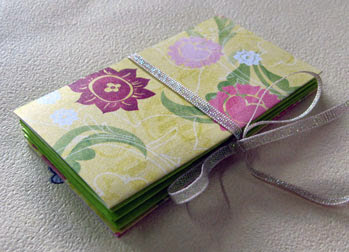
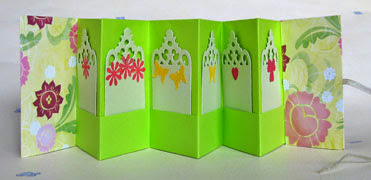
You will need:
* Decorative paper, 14-3/4 by 8-1/2 inches OR
2 sheets of 8-1/2 by 11 inches (letter size) text weight paper
* 2 pieces patterned paper, each 3-1/2 by 4 inches
* Narrow ribbon, 18 inches
* Runner glue
* 12 tags, each around 3 by 1-1/2 inches in size
* Punched paper shapes, small
* White glue
* Ruler
* Pencil
* Cutting mat
* Craft knife
* Bone folder
Making the book
If you are using large decorative paper: Measure, mark and cut the decorative paper to 14-3/4 by 8-1/2 inches. Fold it in half lengthwise. Measure, mark, and score a line one inch from long edge of the paper, then fold this outward. Repeat with the other edge. Fold the paper crosswise into eight equal panels, then accordion-fold along the creases. Proceed to “Making the cover”, below.
If you are using letter size paper: Take one sheet and fold it in half lengthwise. Measure, mark, and score a line one inch from long edge of the paper, then fold this outward. Repeat with the other edge. Fold the paper crosswise into six equal panels, then undo the folds.
Take the second sheet of paper and cut it in half crosswise. Fold it in half parallel to the short side. Measure, mark, and score a line one inch from the edge of the paper, then fold this outward. Repeat with the other edge. Fold the paper into three equal panels and undo the folds.
The two sheets placed side by side will look like this when unfolded:
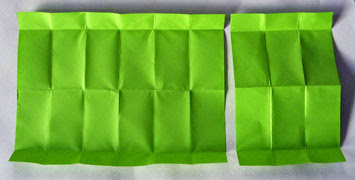
Join the two sheets of paper by overlapping the last and first panel of the full and half sheets, respectively, attaching them with runner glue.
Re-fold the paper, starting with the lengthwise fold, then the edges, then ending with the accordion folds. Now for the cover.

Making the cover
Cut two pieces of patterned paper, each one the length of the book and twice the width of a panel. Score and fold them in half, and set aside.

Cut along the bottom fold of the first panel of the book, stopping about ¼ inch from the fold of the adjacent panel. Cut off the rest of the flap. Repeat with the back of the first panel, and with the last panel as well.
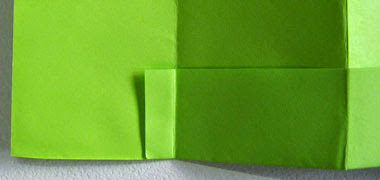
Sandwich the first panel between the halves of the folded cover and glue in place one side at a time using runner glue. Flatten well with your hand. Go to the last panel, and make a slit as wide as the ribbon midway along the fold. Make another slit on the cover, also midway along the fold.

Thread the ribbon through the back cover then through the slit in the book, sandwich the last panel in the back cover, close the book, then gently pull the ribbon around the front so that it is taut and both its ends meet. Apply runner glue to the back cover to attach it to the back panel, working on one side of the cover at a time.
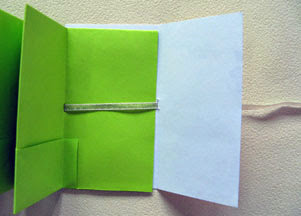
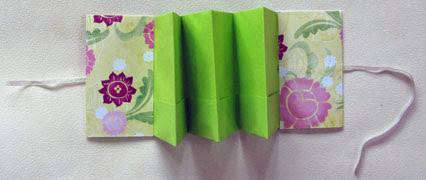
Close the book, tie the ribbon in a bow, and cut off any excess ribbon.
To make the tags:
Punch out small paper shapes from decorative paper or colored cardstock, and glue in place on the tags. You may thread on some ribbon or similar fiber through the tags if you wish. Slip the tags into the individual pockets, close the book, then finish off by tying the bow.
Note that you can use either one large sheet of paper cut down to size, or join several letter-size sheets for the book.
You will need:
* Decorative paper, 14-3/4 by 8-1/2 inches OR
2 sheets of 8-1/2 by 11 inches (letter size) text weight paper
* 2 pieces patterned paper, each 3-1/2 by 4 inches
* Narrow ribbon, 18 inches
* Runner glue
* 12 tags, each around 3 by 1-1/2 inches in size
* Punched paper shapes, small
* White glue
* Ruler
* Pencil
* Cutting mat
* Craft knife
* Bone folder
Making the book
If you are using large decorative paper: Measure, mark and cut the decorative paper to 14-3/4 by 8-1/2 inches. Fold it in half lengthwise. Measure, mark, and score a line one inch from long edge of the paper, then fold this outward. Repeat with the other edge. Fold the paper crosswise into eight equal panels, then accordion-fold along the creases. Proceed to “Making the cover”, below.
If you are using letter size paper: Take one sheet and fold it in half lengthwise. Measure, mark, and score a line one inch from long edge of the paper, then fold this outward. Repeat with the other edge. Fold the paper crosswise into six equal panels, then undo the folds.
Take the second sheet of paper and cut it in half crosswise. Fold it in half parallel to the short side. Measure, mark, and score a line one inch from the edge of the paper, then fold this outward. Repeat with the other edge. Fold the paper into three equal panels and undo the folds.
The two sheets placed side by side will look like this when unfolded:
Join the two sheets of paper by overlapping the last and first panel of the full and half sheets, respectively, attaching them with runner glue.
Re-fold the paper, starting with the lengthwise fold, then the edges, then ending with the accordion folds. Now for the cover.
Making the cover
Cut two pieces of patterned paper, each one the length of the book and twice the width of a panel. Score and fold them in half, and set aside.
Cut along the bottom fold of the first panel of the book, stopping about ¼ inch from the fold of the adjacent panel. Cut off the rest of the flap. Repeat with the back of the first panel, and with the last panel as well.
Sandwich the first panel between the halves of the folded cover and glue in place one side at a time using runner glue. Flatten well with your hand. Go to the last panel, and make a slit as wide as the ribbon midway along the fold. Make another slit on the cover, also midway along the fold.
Thread the ribbon through the back cover then through the slit in the book, sandwich the last panel in the back cover, close the book, then gently pull the ribbon around the front so that it is taut and both its ends meet. Apply runner glue to the back cover to attach it to the back panel, working on one side of the cover at a time.
Close the book, tie the ribbon in a bow, and cut off any excess ribbon.
To make the tags:
Punch out small paper shapes from decorative paper or colored cardstock, and glue in place on the tags. You may thread on some ribbon or similar fiber through the tags if you wish. Slip the tags into the individual pockets, close the book, then finish off by tying the bow.
You Should Also Read:
Accordion Book Project
Purse Mini Book
How to Make a Stitched Book

Related Articles
Editor's Picks Articles
Top Ten Articles
Previous Features
Site Map
Content copyright © 2023 by Mia C. Goloy. All rights reserved.
This content was written by Mia C. Goloy. If you wish to use this content in any manner, you need written permission. Contact Mia C. Goloy for details.


